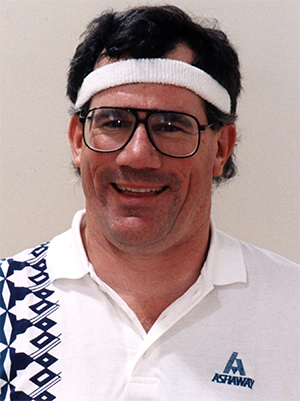|
|

Increase in Hybrid Stringing Driven by "Poly Pain" Says Tennis Industry Expert
By Steve Crandall
Vice President, Sales & Marketing
Ashaway Racket Strings
 Crandall suggests that other 'space age' materials, like the Zyex® polymers used in Ashaway's MonoGut® ZX line offer several advantages over polyesters, either alone or in hybrid setups. Crandall suggests that other 'space age' materials, like the Zyex® polymers used in Ashaway's MonoGut® ZX line offer several advantages over polyesters, either alone or in hybrid setups. |
Stiff polyester string beds a leading cause of arm and joint pain and stiffness
Players of all stripes seeking relief with modified "hybrid" stringing techniques
Ashaway, RI - Roger Federer is often credited with starting the recent trend of tennis players using different string in the mains and crosses, known as hybrid stringing. The process is actually much older, but hybrid stringing has definitely been on the rise in recent years. According to stringing logs, 33% of players at Wimbledon 2014 used hybrid setups, compared to 25% in 2006. Other reports claim 42% of leading pros in the 2015 Australian Open played with hybrid string beds.
There are many reasons for choosing a hybrid setup, the main one probably being the ability of players to totally customize the playability of their string beds. But one industry expert says a key driver is arm and joint pain caused by the ultra-stiff string beds of today's high-end polyester strings.
"There's a reason people call polyester strings 'gut on steroids'," said Steve Crandall, Vice President of leading string manufacturer Ashaway Racket Strings, in a recent column on the Art of Selecting String. "Numerous reports have shown an increase in tennis elbow, muscle strain, and other maladies among players using polyester strings, especially among top junior players."
Tennis elbow results when repetitive twisting, stress or shock to the wrist causes small tears to develop in the forearm tendon that attaches to the elbow. Often a strong backhand is the worst culprit. Poor technique is another factor, but playing time is perhaps the biggest factor, especially for younger players: according to a 2008 Mayo Clinic study, players under 40 who played more than two hours a day had 3.5 times the risk of injury compared to those who played less than two hours per day.
"Increased playing time translates directly into increased impact shock from ball strikes, especially off center hits," said Crandall. "Impact shock exacerbates all of the known risk factors, and today's high-tech polyester and co-polyester strings are well known to increase impact shock. As a string manufacturer we hear complaints about this from customers all the time. One player noted that playing with poly string was like, 'hitting a brick wall with a baseball bat.' We call it Poly Pain."
Crandall believes that the stiffness of polyester monofilaments -- which players use to generate 'formula-one' spin -- is responsible for two trends. One is that recreational players are losing their infatuation with high-end polyester. "They don't like the impact, and they're realizing that normal everyday players just don't get enough benefit from these strings to warrant their added cost," he said. "Instead, they're turning back to more traditional multifilament and synthetic gut strings, which offer a good combination of performance, economy and durability."
The second trend is the huge explosion in hybrid stringing. "It's easy to understand," said Crandall. "Who would want a 100% polyester string bed that is so stiff and unforgiving? Players of all stripes -- including many of the players I saw at last year's US Open -- are using polyesters for stiffness and durability, but mixing it with a softer string for playability."
But, Crandall adds, "Players don't just want a soft string, they want one that helps improve their game." He suggests that other 'space age' materials, like the Zyex® polymers used in Ashaway's MonoGut® ZX line offer several advantages over polyesters, either alone or in hybrid setups.
First, he said Zyex is a soft, arm-friendly string material. Second, it has excellent dynamic stiffness, which, in addition to softness, generates tremendous power (which Crandall calls "Soft Power"). Third, in monofilament form Zyex strings offer spin potential which is right up there with polyesters. And finally, Zyex-based strings offer excellent durability and have natural tension holding characteristics that keep them fresh in your racquet far longer than other materials.
"Now," Crandall added, "everyone's game is unique and string preferences range widely. But from my perspective as a string manufacturer, I don't think today's polyesters are the end of the story."
ZYEX® is a registered trademark of Victrex Ltd.
|